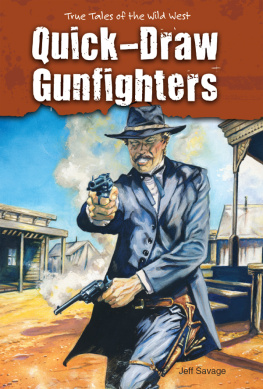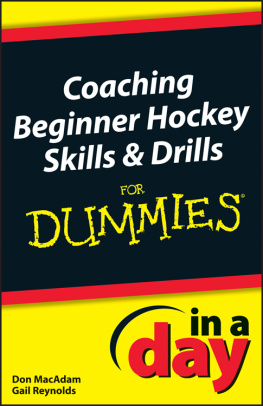FIRE THE WINNING SLAP SHOT!
Hockey is the fastest team sport. Professional hockey players can skate up to thirty miles per hour and can shoot the puck more than a hundred miles per hour. Playing the game at this speed requires a lot of skill and practice on the ice. Top 25 Hockey Skills, Tips, and Tricks details the many important skills you need to know to become a great hockey player, including skating, passing, defense, and a powerful slap shot. Follow these tips and tricks and soon youll be gliding down the ice in a flash to score the winning goal.
About the Author
Jeff Savage has written more than two hundred sports books for students. Jeff lives with his wife, Nancy, and sons, Taylor and Bailey, in El Dorado Hills, California, where he enjoys coaching youth soccer.

Image Credit: Enslow Publishers, Inc.
Skating is the most important skill in hockey. You might be able to slap a puck or block a shot better than anyone. But if you cant skate, you cant excel at hockey. You must be able to skate in any direction, at different speeds, and, most important, under control.
Correct posture is critical to maintaining control on your skates. Your body position will change depending on the direction you go, but there are two general rules you should follow:
- Keep your weight over your skates.
- Keep your head up.
When standing or gliding, your skates should be about shoulder-width apart, knees bent, upper body straight, and chest out. Keep your weight on the flat middle of your skates. When skating slowly forward or backward, you should widen your stance so that you are on the inside edges of your skates. Move your weight forward to the balls of your feet. This is called the ready position. When you skate fast, you are on a single skate, shifting from side to side. Be sure to maintain proper posture while shifting your weight over the skate that is on the ice.
The key to effective skating is quickness. Sheer speed in a race across the ice is important. But in most situations in hockey, it is the first few steps that make the difference. To beat your opponent to a spot or to get a loose puck first, you need an explosive start.
For a quick burst of speed, your toes should be pointed out with one skate slightly ahead of the other. Dig the edge of your forward skate into the ice, bend your knees, and press your weight over your forward skate. This is your push leg. You are coiled and ready to spring. Push hard off your leg. Launch ahead and quickly bring your rear skate forward just above the ice. Shift your weight toward your glide leg. Fully extend your push leg until the toe is up off the ice and your weight is completely over your glide leg. Your glide leg now becomes your push leg. Repeat the process.

Image Credit: Shutterstock.com
Your start technique is important because if you can accelerate quicker than your opponent, you will get to the loose puck first. Once you get going, the fastest skaters take the fewest strides. Long, powerful strides will make you a faster skater.

Image Credit: AP Images / Gene J. Puskar
Pittsburgh Penguins center and captain Sidney Crosby is one of the best players in the NHL. A great skater, he is in constant motion on the ice. This allows him to make plays for himself and his teammates.
Sidney Crosby is the dynamic player from the Pittsburgh Penguins of the National Hockey League (NHL). Crosby uses tricky moves to escape his opponents. Its satisfying to break free when they are shadowing you, Crosby says. You cant afford to go out there and watch too much. If you get caught watching, youre not going to get the puck, and youre not going to make good plays.
Sometimes you need to skate at maximum speed. Avoid the temptation to stand upright. Stay bent at the waist and keep your glide leg bent at the knee to stay low and ready for your next hard push stroke. Extend your back leg as far as possible. Your toe should push off the ice at the last possible instant. To generate more speed, move your arms and shoulders in sync with your legs. For instance, when your right leg moves forward, your right arm and shoulder should swing forward with it. This is the opposite of running, in which your right leg and left upper body move forward together.
You will not always skate in a straight line. To maintain your speed or accelerate in a curve, you want to use the crossover move. That is, you want to cross your outside skate over your inside skate. If you want to curve to your right, with your right knee bent, push off with your left (outside) leg. Lift your left skate and cross it over in front of the toe of your right skate. Push off your right skate and repeat with as many left-skate crossovers as necessary until you are headed in the direction you want to go.

Image Credit: Shutterstock.com
The crossover technique allows a player to accelerate and change direction at the same time. When you crossover to the left, you should be on the outside edge of the left skate and the inside edge of the right skate. The opposite is true for turning right.
Hockey is the fastest team sport. Pro skaters reach speeds up to thirty miles per hour. The puck can travel more than one hundred miles per hour.
Skating backward looks difficult. But it is easier than you think. Squat as though you are about to sit in a chair. Turn your left foot inward and put most of your weight over that leg. Push off the inside edge of your blade. Straighten your left leg as you turn your foot outward so that it curves on the ice in the shape of the letter C. Transfer your weight over your opposite (right) leg. Be sure the gliding skate of your right leg is aimed in the direction you want to go. Now repeat the movement with your right leg. As you push off again, your right foot should form a backward C. Increase your speed by swinging your hips from side to side in sync with your legs. Skating backward is used especially to defend your opponent. Practice it often.

Image Credit: Ken Argent / Frozen Image Photography
Skating backward is especially important for defense. Offensive players have to react quickly to strong backward skaters.
Hockey got its start on frozen ponds and lakes. It began in Europe more than five hundred years ago. The sports origin is unclear. It is believed by some to have gotten its name from the French word hoquet, which means shepherds crook or bent stick. The first use of rules came in 1877 when the Montreal Rules and the Halifax Rules were printed in local Canadian newspapers. Todays game is played mostly on indoor and outdoor rinks. The NHL rink is 200 feet long and 85 feet wide.
























